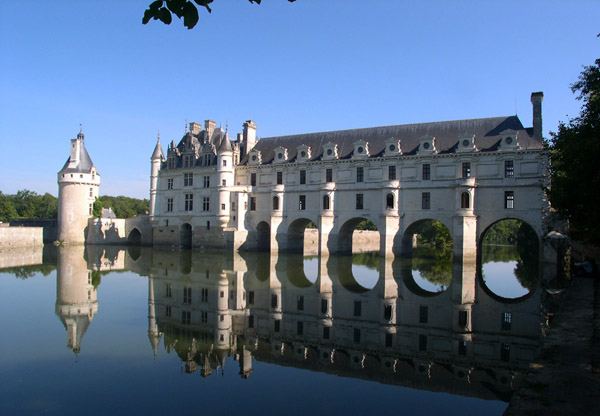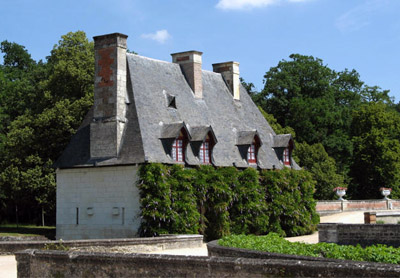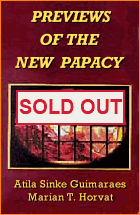Art & Architecture
 |
 |
 |
 |
 |
 |
 |
Regional Splendor &
the Common Man’s Comfort

Is this reality or a fairy tale? One could hesitate in responding, considering the harmony, lightness and supreme distinction of this castle, constructed on serene, deep waters that serve as a dignified mirror for it. One might say that this fabulous façade was made to be seen principally in its reflection in the limpid waters over which it hovers.
Yes, it is real, but it is a fairylike reality born of the French genius. It is the castle of Chenonceaux, constructed in the 16th century, distinguished by a harmonious interpenetration of strength and grace, symmetry and fantasy so typical of the French soul.
The photo sets before us three different elements: a long, uniform main building of a galley, which ends in another quite different structure flanked by narrow turrets. Finally, to the left, a heavy round tower.
The body of the building rests on five arches, which provides its lightness. To prevent the pillars of the arches from being too heavy, each is lightened by a ledge above it that looks like a small tower with a window. Over each turret is another window on the upper floor, which ends gracefully in an ornamental eyehole-window that seems to be smiling in the garret.
The pillar, the turret, the second floor window, and the upper eyehole-window form a single line whose length is reflected in the water, conferring continuity between the building and its reflection. The noble, harmonic arches also benefit by completing themselves in their own reflection.
These two elements - pillars and arches - vigorously ensure aesthetic continuity between the real castle immersed in the diaphanous air, and the unreal castle "immersed" in the waters of the River Cher. The five arches correspond to the five repeated parts in the façade of the gallery. The harmony is perfect. So perfect that it could be considered monotonous if its profoundly placid tone were not harmonically balanced and enhanced by a contrast: its second part.
The second part of the edifice rises massive at its base. With its quadrangular monumental shape and its more combative and noble towers it seems ready for action and the fight, just as the other part over the river seems more suitable for festivals and peace. Considered in itself, this second part also displays a harmonious contrast between strength and grace. Its greatest force is in its base, in the compact part that starts from the river and reaches the start of the towers. The first and second floors are lighter, with their large windows and the poetry of the towers. The dormers and roof add a freshness, diversity and beauty that are almost musical.
To the left, as a grave and venerable memory of other eras, sits the old tower, heroic, serious, unshaken, bathed in an air of legends, symbolizing the firmness of the traditions that are the soul of Chenonceaux. This tower and the part of the castle supported by arches are absolutely heterogeneous. But the central part forms between them a suave transition, which binds everything together in an agreeable ensemble.
It is not hard to imagine what life would be like in this castle in its centuries of glory, for example, on warm and placid evenings with all the lights reflecting on the river and the music soaring through the open windows until it would fade away in the flowers of the parks or on the gently moving surface of the waters…
The 16th century was a complex century, where the neo-paganism that has culminated in our times with the present day apocalyptic crisis was already beginning to show. But it was also a time where many Catholic traditions of distinction, elevation of mind, and harmony of soul still had a great vigor. It was a century where the art itself was still marked by a Catholic grandeur. And what did this century make for the poor? How did the servants of this castle live?
According to a stupid legend, the sumptuousness of the castle was obtained by the oppression of the servants. It would be interesting to organize an album with photographs displaying many of the still remaining residences of the servants of such castles. It would serve to smash this legend.

The guard house of Chenonceaux presents one small aspect of the rural life of the past, which Christian Civilization knew how to make so strong, placid, stable and innocent.
In the 17th century, St. Vincent de Paul, so highly regarded in the high circles of Paris, never wanted his family of modest peasants to change their profession, since he deemed that their condition of life was more favorable for the practice of virtue and the conquest of the Kingdom of Heaven!
And to reach this apex of rural life, neither Socialism nor demagoguery was necessary.

Catolicismo, n 61 – January 1956
Posted October 11, 2013
Posted October 11, 2013
______________________
______________________











